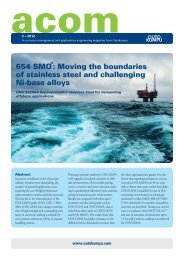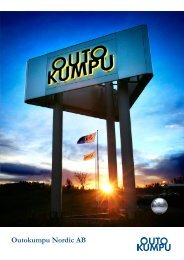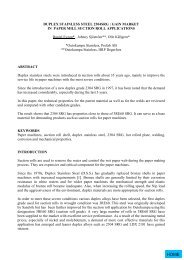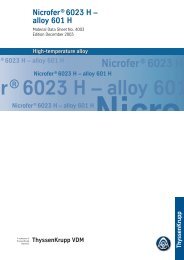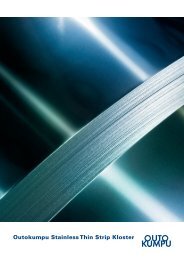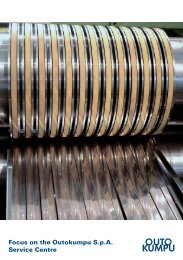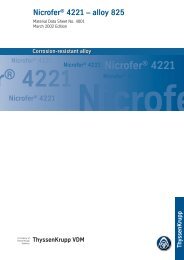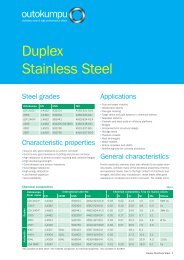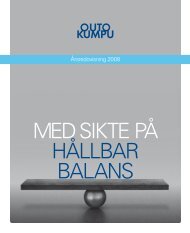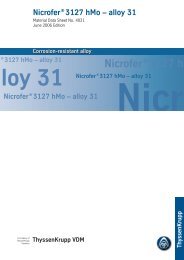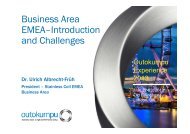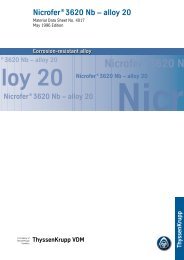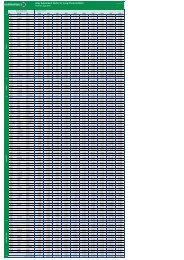Annual Report 2010 - Outokumpu
Annual Report 2010 - Outokumpu
Annual Report 2010 - Outokumpu
Create successful ePaper yourself
Turn your PDF publications into a flip-book with our unique Google optimized e-Paper software.
73<br />
Primary actions included in the programme consist of making further<br />
improvements in energy efficiency, increasing the proportion of low-carbon<br />
electricity and targeting efficiency improvements through optimal levels of<br />
production. An internal air-travel compensation scheme has been implemented for<br />
business travel, and sustainable aspects are gradually integrated to logistics and<br />
transportation solutions. These actions involve <strong>Outokumpu</strong> operations in all<br />
locations and in all business units.<br />
<strong>Outokumpu</strong>'s carbon profile consists of direct emissions from production<br />
operations, indirect emissions from electricity consumed and the emissions<br />
resulting from the transportation of products and business travel, expressed as a<br />
quantity per tonne of stainless steel produced. After <strong>2010</strong>, the Group's carbon<br />
profile was 0.3% lower compared to the programme baseline 2007–2009 average.<br />
This result is primarily due to improvement in energy efficiency and the lowered<br />
emissions of transports. On the other hand, indirect emissions from usage of<br />
electricity were higher compared to the baseline, almost offsetting the<br />
advancement.<br />
Improvements in energy efficiency achieved by <strong>Outokumpu</strong> during 2007–<strong>2010</strong><br />
totalled 3%, equivalent to annual savings of some 160 GWh. The proportion of<br />
low-carbon electricity obtained from renewables and nuclear power was 69%.<br />
Emissions of CO 2 resulting from business travel in <strong>2010</strong> totalled 5 164 tonnes (includes business air travel and company<br />
cars). To compensate for emissions resulting from business air travel in accordance with guidelines in the Energy and<br />
low carbon programme that reflect such activity, an investment will be made in environmental projects that lead to<br />
emissions reductions. The level of such investments will depend on the price of emission allowances, the total number of<br />
kilometres travelled and specific emissions by air carriers. <strong>Outokumpu</strong> has invested in <strong>2010</strong> approximately EUR 90 000<br />
in new lighting systems at the Group's Wildwood tube mill. The annual energy savings achieved total some 1400 MWh,<br />
with a corresponding reduction of 910 tonnes in annual CO 2 emissions.<br />
Continuous improvement in energy efficiency<br />
<strong>Outokumpu</strong>'s approach to energy efficiency is long-term and the target is continuous improvement. Energy efficiency is a<br />
component in the environmental management systems at Group mills. Major <strong>Outokumpu</strong> production sites also have<br />
long-term, prioritised energy efficiency investment plans. In overall terms, the largest energy-saving potential lies in the<br />
recovery of waste heat, improved process integration and improved efficiency in using raw materials.<br />
Large, energy-specific investments are however not the only way of improving energy efficiency within the Group. The<br />
systematic monitoring and analysis of energy consumption plays a very important role, as does life-cycle analysis when<br />
purchases of new electrical equipment are being considered. <strong>Outokumpu</strong> provides its production personnel with training<br />
in energy efficiency.<br />
To meet long-term targets for improvements in energy efficiency, <strong>Outokumpu</strong> arranges for the mapping of energyefficiency<br />
initiatives and investment proposals in order to quantify their improvement potentials and any associated costs.<br />
This mapping process helps optimise energy-efficiency investments at Group level. The aim is a 5% improvement in<br />
<strong>Outokumpu</strong>'s energy efficiency by 2020.<br />
Read more about investments in energy efficiency.<br />
<strong>Outokumpu</strong> <strong>Annual</strong> <strong>Report</strong> <strong>2010</strong> – Business – Energy efficiency




